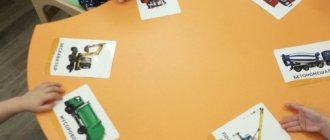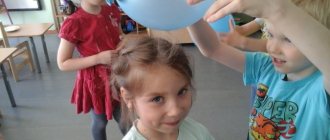Presentation of the educational field “Cognitive Development”
Elena Bogdanova
Presentation of the educational field “Cognitive Development”
Slide 1
I am Bogdanova E.V. teacher of the MBDOU “D/s “Malyshok”. My work experience is 33 years. I'm currently working in 2ml. group
Slide 2
I present to your attention a presentation of the educational field “Cognitive Development”
Slide 3
I would like to start my speech with the statements of famous people:
“The world surrounding a child is, first of all, the world of nature with an endless wealth of phenomena, with inexhaustible beauty. Here, in nature, is the eternal source of children’s intelligence.”
V. A. Sukhomlinsky
“Only that knowledge is lasting and valuable that you have acquired yourself, prompted by your own passion. All knowledge must be a discovery that you have made yourself.”
Korney Chukovsky
Slide 4
Cognitive activity is a conscious activity aimed at understanding the surrounding reality with the help of such mental processes as perception, thinking, memory, attention, speech.
L. S. Vygotsky wrote that mental development expresses something new that is accomplished independently through the new formation of new qualities of the mind and transfers mental functions from a lower to a higher level of development along the lines of voluntariness and awareness.
Slide 5
Relevance: Currently, there is an intensive development of preschool education in different directions: there is an increasing interest in the personality of a preschool child, his phenomenon, the development of his cognitive abilities, which ensure the formation of a holistic picture of the world. In a rapidly changing life, modern man needs not only possession of knowledge, but the ability to obtain it himself, operate with it, think independently and creatively. From birth, a child is already a discoverer, but he himself cannot always find answers to questions of interest. Preparing a child for research activities, teaching the skills of research, becomes the most important task of modern education. For the first time, the Federal State Educational Standard for Education identifies “Cognitive Development” as a separate educational area
Slide6
The goal and objectives are presented on the slide
Slide 7
The educational area “Cognitive Development” contains the following sections of work with children:
Familiarization with the subject environment
Development of cognitive, research and productive activities
Formation of elementary mathematical concepts
Introduction to the social world
Introduction to the natural world
Slide 8 -9
On this and the next slides you see the content of psychological and pedagogical work in five sections of the educational field “Cognitive Development” with children of the second junior group
Development of cognitive-research and productive (constructive) activities
Formation of elementary mathematical concepts
Formation of a holistic picture of the world, broadening one’s horizons
Subject and social environment
Getting to know nature
Slide 10
The educational area “Cognitive Development” successfully integrates with other educational areas:
Social and communicative development
Speech development
Artistic and aesthetic development
Physical development
Slide 11
Cognitive development is present in all types of children's activities
Slide 12
To implement the educational area “Cognitive Development” I use a wide variety of forms of work with children: in the main educational activities I continue to introduce children to their immediate environment, objects in their immediate environment, wild and domestic animals, we continue to get acquainted with color, shape, size, and so on. same with basic mathematical concepts. I also use the following forms of work: reading stories, conversations, discussing what we read, looking at story pictures, watching cartoons, presentations, role-playing games, didactic and theatrical games.
The implementation of educational activities occurs in the process of basic educational activities, during routine moments, during independent activities, in interaction with the families of students. In my work I use such forms of organization as: group, subgroup, individual.
Slide 13
In my work, I try to make maximum use of the authority of the family to consolidate knowledge in the educational field of “Cognitive Development”. Together with parents I conduct entertainment, consultations, surveys, and parent-teacher meetings.
slide 14
A very important condition for cognitive development is a subject-development environment. I pay great attention to creating a subject environment: the group is designed where the necessary gaming material for the development of sensory standards is concentrated. The group has attributes for role-playing games, didactic games and manuals. The kindergarten has a laptop and a multimedia installation, which makes it possible to use ICT in the implementation of the educational field “Cognitive Development”.
Slide 15
In accordance with the Federal State Educational Standard, the necessary conditions are determined for creating a social situation for the development of preschool children.
Slide 16
The following stages of cognitive development are distinguished: Curiosity, inquisitiveness, cognitive interest, cognitive activity
Slide 17
This slide shows the stages of a child’s understanding of the world. Memory, attention, thinking, imagination, sensation, perception lead to the formation of the sensory stage and the stage of logical cognition.
Slide 18 and 19
Here and on the next slide you see the necessary conditions for the formation of curiosity, cognitive interests of children, as well as pedagogical conditions for the successful and full intellectual development of preschool children.
Slide 20 - 21
The Federal State Educational Standard for Preschool Education presupposes the requirements of the basic educational program, which are presented in the form of targets and represent socially normative age characteristics of the child’s possible achievements at the stage of completing the level of preschool education. These slides show early and completion milestones. If we look carefully, these are the achievements that can be achieved by a child in the process of mastering the educational field “Cognitive Development”
Slide 22
on this slide you see some basic concepts of the Federal State Educational Standard for Education for the development of cognitive and research activities
Slide 23
You have now watched an integrated educational activity with children of primary preschool age
based on the fairy tale “Kolobok” using gaming and electronic educational technologies.
You can see the goals and objectives on the slide.
In the main educational activities, I used such methods and techniques as: gaming (finger gymnastics, outdoor game, didactic game) visual (multimedia presentation, verbal (story accompaniment for presentation, method of interest (travel to the forest, use of problem situations (questions, riddles, visual – auditory (listening to music)
In terms of content, OOD is integrated, since its parts are combined with knowledge from several areas. Problem solving is carried out through the following educational areas:
“Cognitive development” (teacher’s story, viewing a presentation, “Speech development” (finger gymnastics) “Social and communicative” (games, element of theatrical performance, “Artistic and aesthetic” (listening to music) “Physical development” (motor activity)
OOD begins with an organizationally motivated moment, where children’s attention is activated and maintained throughout the entire OOD. During the educational activity, children watched a multimedia presentation with narrated slides. The types of activities changed gradually. Children answered questions, played games, solved riddles, and met fairy tale characters. Children were active participants in playful moments during educational activities. Throughout the lesson, I used questions and tasks focused on the zone of proximal development (What to do? What do you think) Children stepped over an imaginary fallen tree. Answered provocative questions (how many ponytails do you have) Collected the picture and found the differences
This allowed us to maintain a positive emotional mood.
Thanks to the elements of theatrical activities, physical activity, gaming activities, and the use of ICT in the implementation of the educational field “Cognitive Development,” I was able to obtain a high-quality level of knowledge for preschoolers in this section. This type of work is carried out with younger children and will become more complicated over time.
Slide 24
In my work I use the following methodological support
Slide 25
Thank you for your attention!
Report “Cognitive development of preschool children in the context of the implementation of the Federal State Educational Standard for Education”
Cognitive development of children is one of the important areas in working with preschool children. A child is born with an innate cognitive orientation that helps him adapt to new conditions of his life. Gradually, cognitive orientation develops into cognitive activity - a state of internal readiness for cognitive activity, manifested in children in search actions aimed at obtaining new impressions about the world around them. As the child grows and develops, his cognitive activity increasingly begins to gravitate towards cognitive activity.
The cognitive development of a preschool child as an evolutionary process goes through several stages: curiosity, inquisitiveness, the stage of development of cognitive interest, the stage of development of cognitive activity, which move from lower to higher in the joint activity of a significant adult and a child.
So, at the stage of curiosity
The preschooler is content with only the initial orientation associated with the interestingness, brightness, and unusualness of the object itself.
Curiosity
represents a valuable state of the individual, an active vision of the world, characterized by the desire of a preschool child to penetrate beyond the boundaries of what was initially seen and perceived. At this stage, strong emotions of surprise, joy of learning, delight, and satisfaction with the activity are manifested.
A new quality of cognitive development of preschool children is cognitive interest.
, characterized by increased stability, clear selective focus on a cognizable object, valuable motivation in which cognitive motives occupy the main place; cognitive interest contributes to the preschooler’s penetration into essential relationships, connections, and patterns of mastering reality.
cognitive activity to be a high level of cognitive development of preschool children
, the basis for the development of which is the holistic act of cognitive activity.
The source of cognitive activity is the cognitive need
, and the process of satisfying this need is carried out as a search aimed at identifying, discovering the unknown and assimilating it.
As recommended types of activities that ensure the cognitive development of preschool children, we highlight:
– organization of solving cognitive problems;
– the use of experimentation in the work of subsidiaries;
– use of design.
When working with preschoolers, cognitive tasks are used,
which are understood as educational tasks that presuppose the presence of search knowledge, methods (skills) and stimulation of the active use of connections, relationships, and evidence in learning. A system of cognitive tasks accompanies the entire learning process, which consists of sequential activities that gradually become more complex in content and methods.
Examples of cognitive tasks may include the following:
Inanimate nature
: Why do tree branches sway? Why are there puddles on the ground? Why is the water frozen outside? Why does snow melt indoors? Why is snow sticky? Why does it rain in summer and spring, and snow in winter? Why does the soil thaw by noon in the spring and freeze by evening? etc.
Live nature
: can plants grow without light (moisture, heat)?
Why do plants grow quickly in spring? Why do plants wither, turn yellow, and lose leaves in the fall? Why is cactus rarely watered, but balsam often? Why do fish swim? etc. After the children accept the cognitive task, under the guidance of the teacher, it is analyzed: identifying the known and the unknown. As a result of the analysis, children make assumptions about the possible course of a natural phenomenon and its causes. Their assumptions are right and wrong, often contradictory. The teacher must listen and take into account all assumptions
and pay attention to their inconsistency. If the children do not put forward any ideas, the teacher himself should put them forward.
A relevant method of cognitive development of preschool children is experimentation,
which is considered as a practical activity of a search nature, aimed at understanding the properties, qualities of objects and materials, connections and dependencies of phenomena.
In experimentation, the preschooler acts as a researcher who independently and actively explores the world around him, using various forms of influence on it. In the process of experimentation, the child masters the position of the subject of cognition and activity.
We offer the following experiments as examples.
1. “Does water have taste?”
2. “What objects can float?”
3. “Where did the ink go?”
Effective methods of cognitive development of preschoolers include project activities that ensure the development of children’s cognitive interests, the ability to independently construct their knowledge and navigate the information space, and the development of critical thinking.
Our projects:
“Autumn World”, Blue Drop”, “Our Good Tales”
"Magic Sand"
It should be remembered that the Federal State Standard considers the formation of a child’s cognitive interests and cognitive actions in various types of activities to be one of the principles of preschool education.
In Object activity, children learn such properties as color, shape, surface character, weight, location in space, temperature, etc. This activity helps children solve the problem through trial and error, i.e. with the help of visual and effective thinking. In Experimenting with sand, water, dough, etc. properties hidden at first glance are revealed: water flows, it is wet, objects sink or float in it….
From Communication with adults, children learn a huge amount of necessary information: the names of objects, actions, properties, the attitude of adults to everything around them. Joint games with peers under the guidance of adults allow children to apply the knowledge and skills acquired earlier. Self-care and actions with household objects-tools enrich children's sensory experience, create conditions for the development of visual and effective thinking, develop small muscles, which has a beneficial effect on the formation of the frontal lobes of the children's brain.
Poems, fairy tales, songs not only provide emotional pleasure, but also enrich children’s ideas about the world, taking it beyond the limits of the directly perceived.
Looking at pictures helps enrich sensory experience and develop visual-figurative thinking.
Motor activity, to a lesser extent, but also affects the cognitive development of children. Firstly, it relieves stress, and in addition, here children receive a lot of information about their own body, its capabilities, in outdoor games they learn to understand - bunnies jump, foxes run, a bear waddles from side to side, etc.
In preschool age, play comes first in importance among the types of activities in which cognitive development occurs.
The main types of games are role-playing, directing, theatrical, because in these games the child’s desire for independence and active participation in the life of adults is satisfied. A game for a preschooler performs the same function as a textbook for schoolchildren; it helps to understand what is happening around them. All games, including educational games and games with rules, satisfy the need for knowledge of the environment.
Communicative activities, compared to communication at an early age, become more meaningful. Children are able to express their opinions, ask “chains” of questions, discuss serious issues, and insist on something.
Cognitive and research activities, when properly organized, teach children to see a problem, look for ways to solve it, record the result, and analyze the data obtained.
Self-service and basic household work become noticeably more complicated and allow children to identify more properties of objects and gain new knowledge.
Construction, visual activity, and musical activity, of course, mainly solve the problems of the artistic and aesthetic development of children, but at the same time they learn a lot about the means and materials with which they work, and get acquainted with works of art.
Thus, we can conclude that each of the children's activities makes it possible to realize the content of cognitive development, integrating it with other educational areas.
So, the content of children’s cognitive development presupposes: the development of children’s interests, curiosity and cognitive motivation; formation of cognitive actions, formation of consciousness; development of imagination and creative activity; the formation of primary ideas about oneself, other people, objects of the surrounding world, about the properties and relationships of objects of the surrounding world (shape, color, size, material, sound, rhythm, tempo, quantity, number, part and whole, space and time, movement and rest , causes and effects, etc.), about the small homeland and Fatherland, ideas about the socio-cultural values of our people, about domestic traditions and holidays, about planet Earth as the common home of people, about the peculiarities of its nature, the diversity of countries and peoples of the world.
Thus, provided that the pedagogical process is properly organized using methods, usually playful, that take into account the characteristics of children’s perception, as well as with a properly organized subject-development environment, children can already assimilate the proposed material at preschool age without stress overloads.
I wish you success in the cognitive development of your children!
PETROVOBUDSKY BRANCH MBDOU
MIRNINSKY KINDERGARTEN “SUNNY”
REPORT FOR THE SEMINAR ON THE TOPIC:
«
Cognitive development of preschool children in the context of the implementation of the Federal State Educational Standard for Educational Education"
TEACHER: VLASENKO GALINA PETROVNA




